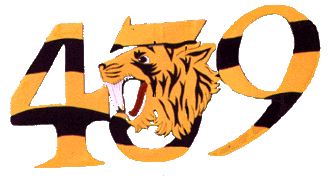|
History
of
 Squadron Squadron
  
Chapter
V
Recce,
Rails and Flak
September
- October 1944
|
The rail line at Almelo, Holland, was cut again on the 24th, with at least two direct hits. Then for three days cloud and haze thwarted operations
"a bit annoying to say the least. "
When the 28th dawned bright and clear the diarist caustically remarked that
"it took us some time to become accustomed to the solar rays." Taking full advantage of this most unusual weather, the squadron completed four tasks against three rail lines and a
canal bridge. The first in the series encountered a terrific storm of anti aircraft fire.
"The leader, F/L Jimmy Hogg, had
barely commenced his dive on the rail line near Twello, west of Deventer, when the flak started to come up, first a trickle of 20 mm., then a dense curtain of 40 mm. and soon the 88s added to the barrage to create one of the fiercest flak curtains the pilots have yet
encountered. It was inevitable that some one would get hit."
|
Intentionally
left blank
|
Intentionally
left blank
|
The fifth aircraft, flown by
F/0
M.P. Laycock, burst into flames and spun into the ground. The others pressed home their attack, smashing one pair of bombs
squarely on the mark with the others very close.
Heavy flak escorted them all the way back to the Rhine. Maurice
Laycock, an earnest, devout young man who had planned to enter the ministry when the war ended, was one of the few remaining veterans of Debert days. He had joined No. 123 Squadron in January 1943 and, with 77 sorties to his credit, was nearing the end of his tour.
Flak was again intense when the pilots later that morning once more visited the familiar target at Almelo, but the enemy gunners were late in opening fire and the Tiffies had finished their dives before it was too much of a hazard. The first bombs miscarried because of the strong west wind, but F/O Rassenti made the necessary correction for drift and crashed his pair right on the rails. Farther to the west, between Rijssen and Deventer, another line was blown up later in the day.
|
(1) According to the information which F/O Smith brought back, the intelligence on which the attack on 22 October was based was at fault. A Dutch hospital orderly told him that the buildings were not an enemy headquarters but were occupied by civilians, many of whom were killed or injured.
But the best show of the day was undoubtedly the demolition of a small bridge by four pilots led by S/L
Fiset. The Army had requested the strike to impede enemy movements across the canal nearDeurne, north west of
Venlo, and
had agreed to mark the target with red smoke. When the four Tiffies arrived over the area no identifying smoke could be seen but after a few moments the Army laid it on and down came the pilots in a steep 70 degree dive from 8000 to 2000 feet. Three pairs of 1000 lb. bombs fell squarely on the bridge, completely demolishing it. There was not much flak but one lucky burst struck the C.O.'s aircraft,loosening a panel below the cockpit. Fiset was somewhat startled by
the great gust of air until he discovered the cause.
  
Copyright
©1998-2016 Michael T. Melnick. All rights reserved
the
unofficial homepage of  Tiger
Squadron Tiger
Squadron
.
.
|
|